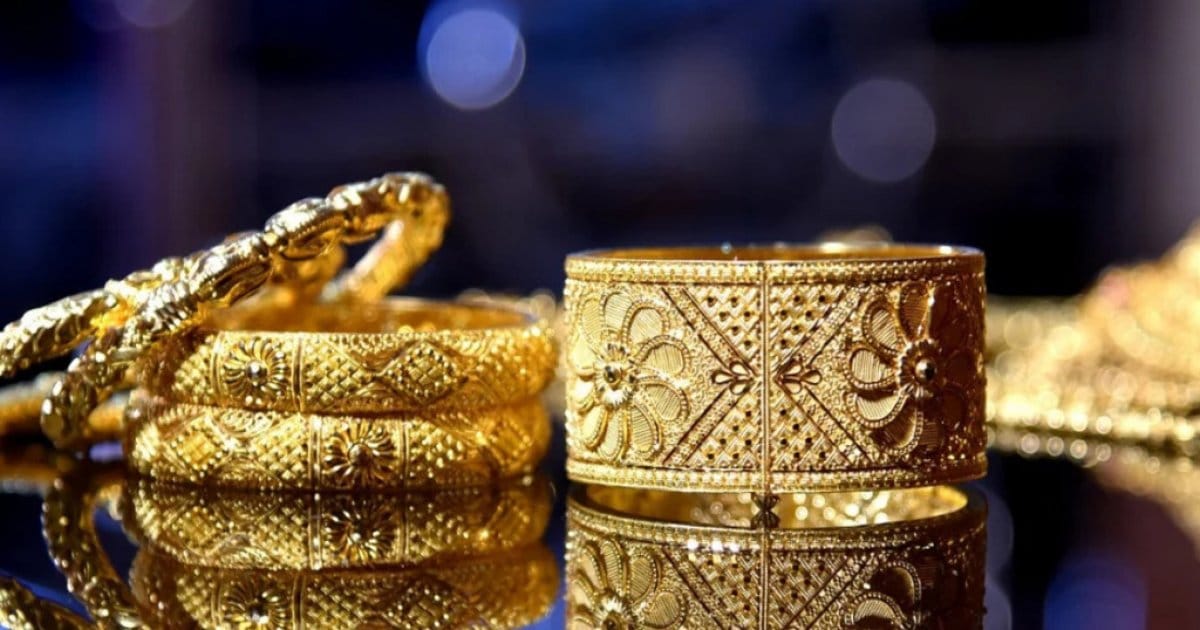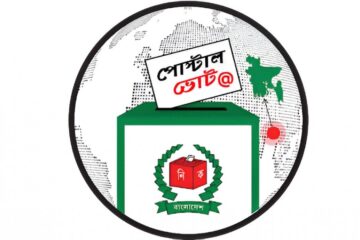The country has been witnessing a continuous rise in prices in the gold market for the last three years.
This rise in prices is not just recent. An analysis of two decades of data shows that in 2000, the price of 22-carat gold per bhori was only Tk6,900.
A decade later, in 2010, it increased to Tk42,165.
In 2020, the price reached about Tk70,000, and in 2023, the price of gold crossed Tk1 lakh for the first time.
Now the price has crossed almost Tk2.5 lakh—a historical record in the country’s gold market.
On Tuesday (October 14), the price of a bhori (11.664 grams) of 22-carat gold was increased to Tk2.16 lakh.
The previous day, Monday (October 13), the price of a bhori of 22-carat gold was Tk2.13 lakh.
The price of this product has not only increased in the country, but also in the international market; the price of gold has now crossed the highest level in history.
On Monday (October 13), at 10:50 am local time (1450 GMT), the price of gold per ounce in the spot market rose to $4,99.55, touching $4,103.58 for some time.
Why are prices increasing?
Analysts say that investors are leaning more towards gold due to geopolitical instability, global economic recession, an increase in import duties, and international uncertainty.
The demand for gold as a safe investment medium is increasing in the global market, which is also directly affecting the Bangladesh market.
Masudur Rahman, chairman of the standing committee of the Bangladesh Jewelers Association (BAJUS), believes that the price may increase further if the current trend continues. In his words, “The future price of gold depends entirely on the global market and the gold reserve policies of central banks. If demand increases in the international market, this trend of price increase in the domestic market is not unusual.”
However, as a result, ordinary buyers are facing difficulties. Masudur Rahman said, “The price of gold has now gone beyond the reach of many. Many craftsmen are becoming unemployed due to the decline in sales.”
The rising price of gold in the international market has not only affected Bangladesh but also created new records in the South Asian market.
This rise in the price of gold has affected almost all the countries of South Asia—especially the markets of Bangladesh, India, Pakistan, Sri Lanka, Nepal, Bhutan, and the Maldives.
Bangladesh: New history at record prices
Gold is being sold at the highest price in the Bangladesh market so far. The latest price announced by the Bangladesh Jewelers Association (BAJUS) has put the price of 22-carat gold at Tk 216,332 per bhori. And the price of gold per gram is Tk 18,547. Currently, 1 US dollar is equal to about Tk 121.80.
Market analysts say that the devaluation of the rupee and the increase in the price of acid gold in the international market are the two reasons for the continuous increase in the price of gold in the country.
In this context, Consumers Association of Bangladesh (CAB) Senior Vice President SM Nazer Hossain said that the gold business in the country has now come under the control of corporate groups. As these influential businessmen control the market, the price of gold is increasing at a reckless rate, resulting in extreme suffering for ordinary buyers.
He told Bangla Tribune, “Buying gold for weddings or other social events has now become a big burden for many families. Those who used to use gold as a hobby are now also unable to buy it. This is basically nothing but a kind of manipulation.”
He also said, “This situation has arisen because the gold market has gone beyond the effective control of the government. Earlier, allegations of gold smuggling were heard in neighboring countries, but now the bigger concern is that corporate traders are influencing this market within the country.’’
Nazer Hossain believes that there are already various loopholes and irregularities in the gold trade. The market has now become more unstable due to the influence of corporate groups.
He said, “To bring control to the gold trade, the government should formulate appropriate laws and policies. This will protect consumer interests and bring transparency to the market.”
Talking to gold traders, it was learned that the market is now in such a situation that it has become practically impossible for the middle and lower middle class to buy gold. Once, buying gold as a safe means of saving for marriages, festivals, or the future was part of the family culture, but now it has become a luxury item.
A jeweler owner in Dhaka’s New Market area said, “Earlier, someone or other would come to the shop every day to make jewelry or exchange old jewelry. Now many people come only to look, not to buy. The number of buyers has decreased, but the price is increasing.”
Govinda Halder, a veteran gold trader from the traditional Tanti Bazar in Old Dhaka, has been involved in this profession for almost five decades. He reminisces, “Before independence, the price of a guinea gold was only 150 taka per baht. Even then, people used to say the price was high. But now the situation has become more difficult.”
Sagor Sarkar, in charge of Diamond World’s Gulshan branch, said that usually when the price of gold increases, sales increase slightly. Because people assume that the price will increase further. But this time, the opposite is happening. “Many buyers can no longer afford to buy gold,” he said.
Gold price in India
Prices have increased in the Indian gold market, but it is slightly lower than in Bangladesh.
On Wednesday (October 15), the price of 24-carat pure gold stood at Rs12,453 per gram in the Mumbai market, which is about Tk15,916.
The price of 1 bhori (11.66 grams) of gold stands at about Rs185,580.
The price of 22-carat hallmark gold is slightly lower. The price per gram is about Rs11,860, which is between Tk15,900 and Tk15,920 in Bangladeshi currency.
According to analysts, the central bank’s import duty and the surge in demand during the festive season have the biggest impact on prices in India’s huge gold market.
Due to this, while the price in the Indian market is relatively stable, the price of gold in Bangladesh is slightly higher.
Gold traders say that the price of gold naturally fluctuates when demand for festivals and weddings increases.
However, currently, the price in the Indian market is slightly lower, making it relatively affordable for Bangladeshi buyers.
Pakistan
The sharp depreciation of the Pakistani currency, the rupee, has led to a sharp increase in the price of gold in the local market. Last Friday (October 10), the price of 1 gram of the best quality gold, i.e., 24-carat gold, was Rs36,788, which is about Tk15,870 in Bangladeshi currency. It is priced at around Tk185,000 per bhori.
After two days of market closure, the price increased slightly on Monday and rose to Rs37,021 per gram of gold, about Tk15,900 in Bangladeshi currency and about Tk185,500 per bhori.
Sri Lanka
Although Sri Lanka’s economy has turned around somewhat after IMF assistance, the price of gold in the Colombo market is slightly lower than in Bangladesh.
On Monday (October 14), 22-carat gold was sold for Rs40,620 per gram. Currently, US$1 is equal to Rs302.85 in the country.
When calculated in Taka, the price of one bhori of gold stands at about Tk190,500.
Nepal
The price of 22-carat gold in the Nepalese market is currently about Rs10,892 per gram, which is about Tk9,366 in Bangladeshi currency according to the current exchange rate.
The price of one bhori (11.66 grams) of gold is about Rs126,900—about Tk109,150.
Analysts believe that the gold market in Nepal is relatively stable, mainly due to the festive season and investment.
Bhutan
As Bhutan’s currency, the ‘ngultrum,’ is exchanged at the same value as the Indian rupee, the country’s gold price also moves in line with neighboring India.
In the Thimphu market, the current price of 22-carat gold per gram stands at 10,898 ngultrums, which is equivalent to about Tk14,900 in Bangladeshi currency.
Based on this, the price of one bhori has reached about Tk173,793.
Although the market size is small, the demand for gold in Bhutan is still stable. Gold trading remains an integral part of the country’s cultural heritage, particularly during Buddhist religious festivals, weddings, and family rituals.
Maldives
The gold market in the tourism-dependent country of Maldives is also on the rise. In the capital, Male, 22-carat gold is being sold for 1,885 Maldivian rufiyaa per gram. The currency in the country is currently 15.4 rufiyaa to the dollar, which is about Tk176,000.
According to analysts, the foreign exchange flow from tourism in the Maldives is helping to keep the market stable, but the impact of the global market is clearly felt here too.
Exchange rate is the main regulator
According to analysts, the exchange rate of the local currency is having the biggest impact on the gold market in South Asia.
The Indian rupee is somewhat stable against the Taka, but the Pakistani rupee and Sri Lankan rupee have weakened significantly.
If the currency rate decreases against the dollar, import costs increase, which is directly reflected in the price of gold.
The dollar exchange rate also directly affects the country’s gold purchases. The exchange rate of a dollar in Bangladesh is now around Tk121.80, Rs87.78 in India, Rs283.58 in Pakistan, Rs142.11 in Nepal, 86.58 ngultrums in Bhutan, Rs302 in Sri Lanka, and 15.41 rufiyaa in the Maldives.
That is, the difference in the value of the currency is affecting the purchasing power of gold.
Analysts say that the price of gold may become more volatile due to fluctuations in the international market and changes in the value of the local currency.
The gold market in Bangladesh is at its peak due to the demand for festivals and weddings and the increase in buying trends for investment.
Experts advise buyers to be careful, monitor the market, and invest at the right time.
Economic analyst Mahbubur Rahman told Bangla Tribune that in countries where there is a dollar crisis or currency depreciation, the price of gold is also relatively high. This is a kind of “macroeconomic reflection.”
Economists say that overall, the price of gold has now created a new reality in the South Asian market.
Although the economy, monetary policy, and international market pressures of each country are different, the overall picture is the same—gold is now more expensive and in demand than ever before.


